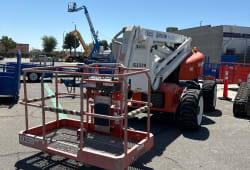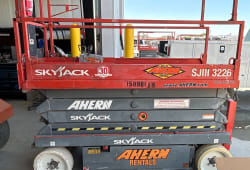Grading Excellence: Unveiling the Secrets of Top-Notch Motor Graders
10 Min read
)
January 19, 2024
In the world of construction and road maintenance, motor graders play a pivotal role in achieving precise and efficient grading. Understanding the secrets behind top-notch motor graders is essential for construction professionals looking to elevate their projects. This blog explores the key elements that contribute to grading excellence and unveils the secrets of these sturdy machinery.
I. Anatomy of a Motor Grader
A. Blade Design and Configuration
The first secret to a top-notch motor grader lies in its blade design. Explore the different blade configurations and how they impact grading precision. From straight blades to dual-angled blades, understanding the anatomy sets the foundation for excellence.
Straight blades are the most basic type, featuring a single cutting edge. They are versatile and suitable for various grading applications.
Dual-angled blades, also known as V-type blades, have two cutting edges set at an angle. This configuration enhances the cutting ability and is effective for tasks that require a more aggressive approach.
The moldboard, the main component of the blade, comes in various designs such as curved, flat, and curved with a flat top. Each design serves specific purposes, influencing the way the grader cuts and moves material.
B. Frame and Chassis Construction
The structural integrity of a motor grader is paramount. Delve into the materials used in constructing the frame and chassis, and learn how durability and stability are achieved. A robust frame ensures longevity and optimal performance.
II. Power and Performance
:format(webp))
A. Engine Horsepower
The engine horsepower of motor graders can vary widely depending on the specific model and manufacturer. These are heavy equipment used for grading and leveling surfaces, especially in the construction and maintenance of roads. The horsepower of a motor grader's engine is a crucial factor in determining its performance and ability to handle different types of terrain and grading tasks.
Motor graders typically have a range of engine horsepower options to suit various applications. Smaller motor graders may have engines with horsepower in the range of 100 to 200 horsepower, while larger and more powerful graders can have engines with horsepower exceeding 300 or even 400 horsepower.
B. Transmission Systems
Examine the various transmission systems employed in motor graders. From manual to automatic transmissions, understand how these systems impact control and precision during grading operations. The transmission systems in this machinery play a crucial role in controlling the speed and power delivery to the wheels, allowing for efficient operation during grading and leveling tasks.
Powershift Transmission: Many motor graders are equipped with powershift transmissions. Powershift transmissions allow for quick and smooth shifting between gears without the need for clutching. This is particularly useful in grading applications where precise control of speed is essential.
Hydrostatic Transmission: Some motor graders use hydrostatic transmissions, which provide infinite speed control in both forward and reverse directions. Hydrostatic transmissions use hydraulic pumps and motors to control the speed, offering good maneuverability and ease of operation.
Direct Drive Transmission: Some motor graders may have a direct drive transmission system, where power is transmitted directly from the engine to the wheels without the need for a torque converter. This type of transmission is known for its simplicity and efficiency.
Variable Horsepower Transmission: In certain motor graders, there may be transmission systems that adjust the power delivered to the wheels based on the load and operating conditions. This helps optimize fuel efficiency and overall performance.
Electronic Controls: Modern graders often feature electronic controls for transmission systems. These electronic systems may include features such as automatic shifting, adaptive controls, and integrated systems that enhance overall performance.
III. Advanced Control Systems
A. GPS and Automation
Explore the integration of GPS technology and automation in modern graders. Understand how these advanced control systems contribute to accuracy and efficiency, reducing operator fatigue and ensuring consistent grading results.
GPS Technology
Grade Control Systems: Many modern motor graders are equipped with GPS-based grade control systems. These systems use satellite signals to accurately determine the grader's position on the job site. The information is then used to adjust the blade height and angle automatically, ensuring precise grading according to the design specifications.
Real-Time Monitoring: GPS technology enables real-time monitoring of the grader's position and performance. This information can be displayed on the operator's console, allowing for better control and management of the grading operation.
Data Logging: The GPS system may also log data related to the grading task, providing valuable information for project documentation, analysis, and optimization.
Automation Features
Automation features in motor graders often include automated blade control. This allows the grader to maintain a consistent blade angle and height, resulting in more accurate and uniform grading.
Some graders have automation features related to articulation, which is the ability of the grader to pivot around its center. Automated articulation control can enhance maneuverability and efficiency on the job site.
They are of the grading process, reducing the operator's workload and increasing overall productivity.
Telematics systems may be integrated into this machinery, allowing remote monitoring of machine health, performance, and location. This information can be used for fleet management and preventive maintenance.
B. Joystick Controls
Dive into the world of joystick controls and their role in enhancing operator comfort and control. Learn about ergonomic design principles and how they influence the ease of operation, leading to more precise grading. Joystick controls in a motor grader provide operators with a more intuitive and ergonomic way to manipulate the machine's functions. These controls are designed to enhance precision and ease of use during grading and leveling tasks.
Joystick controls are often used to manipulate the position and angle of the grader blade. Operators can use the joystick to raise, lower, tilt, and angle the blade to achieve precise grading results.
A motor grader typically has an articulating frame, allowing them to pivot around a central point. Joystick controls may be employed to articulate the frame, making it easier for the operator to navigate tight turns and maneuver the grader effectively.
Joysticks can be used to control the speed and direction of the motor grader. This allows for smooth and responsive adjustments while navigating the job site.
Some motor graders feature joysticks with integrated buttons or switches that control additional functions, such as activating differential locks, engaging work lights, or adjusting the machine's speed settings.
Joystick controls are designed with operator comfort in mind. They are often placed within easy reach of the operator's natural hand positions, reducing fatigue during extended operation.
Modern graders may incorporate electronic control systems that enhance the responsiveness and precision of joystick inputs. These systems may offer customizable settings to tailor the controls to the operator's preferences.
Common mistakes to avoid when operating a motor grader
:format(webp))
Operating a motor grader requires skill, attention, and adherence to safety guidelines. Avoiding common mistakes is crucial to ensure efficient and safe grading operations. Here are some common mistakes to avoid when operating a motor grader:
Lack of Familiarity
Mistake: Operating a motor grader without proper training and understanding of its controls.
Solution: Ensure that operators undergo comprehensive training programs to familiarize themselves with the grader's functions, controls, and safety features.
Incorrect Blade Positioning
Mistake: Failing to adjust the blade height, angle, or tilt properly for the specific grading task.
Solution: Always set the blade to the correct position according to the job requirements and ground conditions. Regularly check and adjust the blade during operation.
Inadequate Inspection
Mistake: Neglecting pre-operational checks and inspections.
Solution: Conduct thorough pre-operational inspections to identify and address any mechanical issues, fluid levels, or safety concerns before starting the motor grader.
Failure to Check the Surroundings
Mistake: Not being aware of the surroundings, leading to potential collisions or accidents.
Solution: Regularly check the work area for obstacles, other equipment, and personnel. Use mirrors and backup alarms to enhance visibility and awareness.
Ignoring Manufacturer Guidelines
Mistake: Disregarding the manufacturer's guidelines and operating instructions.
Solution: Always follow the manufacturer's recommendations regarding operating procedures, maintenance schedules, and safety precautions.
Improper Speed Control
Mistake: Operating the motor grader at excessive speeds, compromising control and safety.
Solution: Adhere to recommended speed limits for specific tasks. Slow down in challenging terrain or congested work areas to maintain control.
Neglecting Grading Surface Conditions
Mistake: Failing to assess and adapt to changing ground conditions.
Solution: Continuously evaluate the grading surface, considering factors such as moisture, soil type, and slopes. Adjust the grading technique accordingly.
Overloading the Grader
Mistake: Attempting to move too much material at once, exceeding the grader's capacity.
Solution: Follow load capacity guidelines and avoid overloading the grader to prevent strain on the engine and components.
Poor Communication
Mistake: Lack of effective communication with ground personnel or other equipment operators.
Solution: Maintain clear communication channels with the ground crew and other operators, especially when working in a team or shared workspace.
Neglecting Regular Maintenance
Mistake: Postponing or neglecting routine maintenance tasks.
Solution: Adhere to the recommended maintenance schedule, including checking fluids, lubrication, and inspecting wear parts. Regular maintenance ensures optimal performance and prolongs the machine's lifespan.
In conclusion, motor graders are essential pieces of heavy equipment widely used in the construction and maintenance of roads, as well as other grading and leveling tasks. These machines play a crucial role in shaping and preparing surfaces with precision.

Caleb Woods is an experienced content specialist and an editor at Boom & Bucket, blending his journalism background with expertise in the heavy equipment industry. He delivers engaging, informative content to help professionals stay informed and make smarter decisions in the machinery market.











